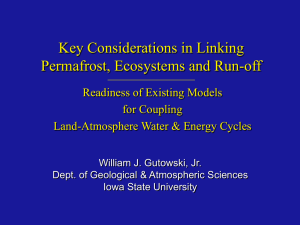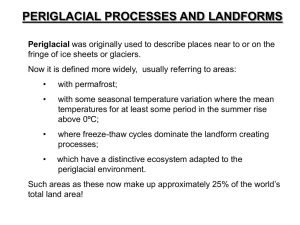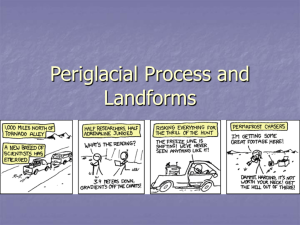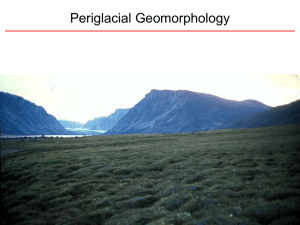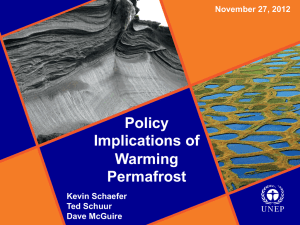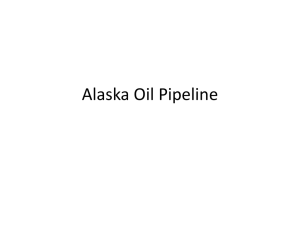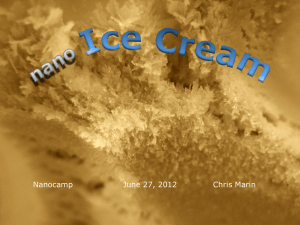Assessing the Resilience and Vulnerability of Permafrost
advertisement
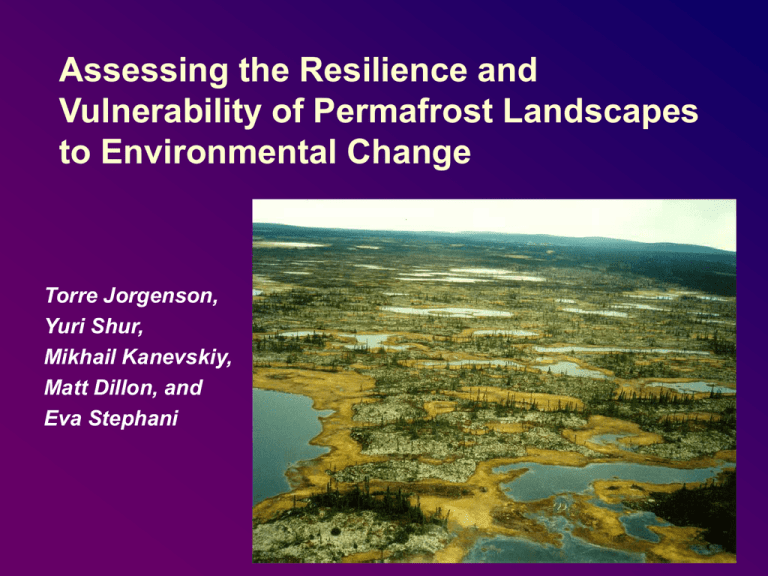
Assessing the Resilience and Vulnerability of Permafrost Landscapes to Environmental Change Torre Jorgenson, Yuri Shur, Mikhail Kanevskiy, Matt Dillon, and Eva Stephani Approach to Assessing Permafrost Stability • Define permafrost in relation to climate and ecosystems • Determine ground ice characteristics in relationships to terrain units • Assess magnitude of positive and negative feedbacks related to vegetation and water • Compare permafrost stability in relation to terrain Redefined Permafrost in Terms of Climate-Ecosystem Relationships Shur, Y. L. and Jorgenson, M. T. 2007. Patterns of permafrost formation and degradation in relation to climate and ecosystems. Permafrost and Periglacial Processes 18: 7-19. Climate-driven, Ecosystem-modified Permafrost Ecologically mediated ice aggradation increases vulnerability to degradation Vegetation-soil processes in the thinning active layer allow accumulation of 2-3 m of excess ice during floodplain evolution. Buildup of excess ice in upper permafrost form conditions for development of thaw lakes, even under cold climates Thermokarst lake development at MAATs of -12 C Ecosystem-Driven Permafrost Ground ice aggradation in relation to Sphagnum growth Soil drainage after permafrost degradation Ecosystem-Protected Permafrost Fish Creek MAAT -11.5 C Ataxitic ice in syngenetic permafrost formed in cold climates Naknek Lake MAAT +1.5 C Layered ice in epigenetic permafrost formed in “warm” climates A New Permafrost Map for Alaska Map based on terrain units and climate From Jorgenson et al. 2008. Permafrost Characteristics of Alaska. NICOP Proceedings Relating Ground Ice to Terrain Units Glaciomarine Kanevskiy et al. submitted Loess Kanevskiy et al. submitted Colluvium From Jorgenson et al. 2008. Permafrost Characteristics of Alaska. NICOP Proceedings Ice Volume in Relation to Terrain Units Terrain Unit Alluvial-marine Deposit Thaw Basin, IceRich Center Lacustrine Organic Silt Thaw Basin, IceRich Margin Thaw Basin, IcePoor Margin Thaw Strain Eolian Sand Mean Visible Ice 0 20 40 60 Excess Segregated Ice Volume (%) Eolian Sand Buried Glacier Ice Barter Island Abundant in Wisconsin and Little Ice Age Moraines Toolik Lake, NE14 Basal Ice Matanuska Glacier Basal Ice Barter Island Kanevskiy, M., T. Jorgenson, Y. Shur, and M. Dillon (2008), Buried glacial basal ice along the Beaufort Sea Coast, Alaska, Eos Trans. 89, 53, C11D-0531. Generalized ice profiles for common types of permafrost Resilience and vulnerability of permafrost depends on type and amount of ground ice Conceptual model by M. Kanevskiy Jorgenson, M. T., Romanovsky, V., Harden, J., Shur, Y., O’Donnell, J., Schuur, E. A. G. and Kanevskiy, M. 2010. Resilience and Vulnerability of Permafrost to Climate Change. Canadian J. Forest Research. Feedbacks Strongly Affect Permafrost Stability Permafrost can degrade at MAATs of -20 C due to surface water Permafrost can persist at MAATs of +2 C due to protection by vegetation and organic soil Jorgenson, M. T., Romanovsky, V., Harden, J., Shur, Y., O’Donnell, J., Schuur, E. A. G. and Kanevskiy, M. 2010. Resilience and Vulnerability of Permafrost to Climate Change. Canadian J. Forest Research. Effects of Vegetation-Soil and Water on Ground Temperatures Negative Feedback from Vegetation-Soils Positive Feedback from Water •Vegetation and soil reduce permafrost temperatures by 7 deg. C. •Water can raise ground temperatures by 12 deg. C. •Positive and negative feedback effects are larger than predicted climate warming Thermal modeling by V. Romanovskiy in: Jorgenson, M. T., Romanovsky, V., Harden, J., Shur, Y., O’Donnell, J., Schuur, E. A. G. and Kanevskiy, M. 2010. Resilience and Vulnerability of Permafrost to Climate Change. Canadian J. Forest Research. Landform–Soil–Vegetation-Permafrost Relationships Alpine Rocky Dry Dwarf Scrub Upland Moist Tall Scrub Upland Wet Needleleaf Forest Bedrock Upland Moist Broadleaf Forest Upland Moist Needleleaf Forest Lowland Wet Loess Forest Lowland Wet Low Scrub Retransported Silt Riverine Barrens Lowland Bog Meadow Lowland Tussock Bog Lake Thick Peat Stratified Silt and Sand Lowland Lowland Broadleaf Forest Fen Meadow Gravel Riverbed PF Loamy Rocky Upland Lowland Resilience of Silty Uplands •Slopes shed water, reduce positive feedback High ice content and latent heat slow thawing Vegetation recovery after fire, allow negative feedbacks to stabilize permafrost. Ice-poor silt freezes back. High Vulnerability of Silty Lowlands Innoko Flats 38 Innoko Toposequence Ground Surface 37 Water Surface Permafrost Table 36 Unfrozen Depth 35 Flat terrain allows water to impound, creating positive feedback to ground temperatures Elevation (m) 34 33 32 31 30 29 28 27 26 0 100 200 300 400 Distance (m) 500 600 700 Gravelly Lowlands with Thaw Lake Sinks Yukon Flats Lake drainage after losing permafrost curtain? CONCLUSIONS • Large climate gradient across Alaska creates range of permafrost temperatures and ground ice conditions • Ground ice develops in response to temperature, soil texture, and ecology • Permafrost can be highly resilient due to vegetation-soil development, yet highly vulnerable due to water • Permafrost degradation sensitive to many interacting factors but can be broadly grouped by topography and soils.
